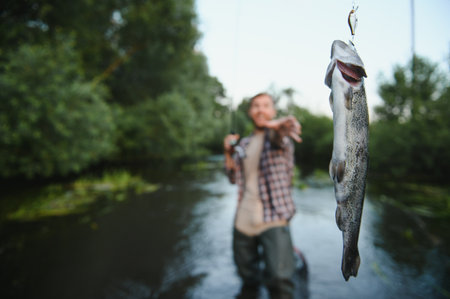1. Carp Only Feed at Dawn or Dusk
If you’ve spent any time on the bank with a flask of tea and a bacon butty, you’ve probably heard someone swear blind that carp only get their heads down to feed at first light or as the sun dips behind the trees. While there’s some truth that dawn and dusk can be productive, it’s far from the whole story when it comes to British stillwaters. In reality, carp have adapted to our ever-changing weather and angling pressure, and they’re just as likely to have a munch at midday as they are during those golden hours.
On many popular UK waters, especially those with high angler presence, carp quickly learn not to stick to a strict breakfast or supper routine. Overcast days, warmer water temps, or even a sudden change in wind direction can trigger feeding spells at all sorts of unexpected times. I’ve personally watched big mirrors cruise in for a feed under blazing afternoon sunshine – no twilight required!
The key for us British anglers is not to pack up your kit just because the clock says so. Stay observant: fizzing bubbles, subtle bow waves, or even an odd tail pattern breaking the surface can signal hungry carp outside the supposed “prime times.” Next time you’re bivvied up for a session, keep your rigs sharp and your bait fresh throughout the day – you might just bank your PB while everyone else is snoozing in their chairs.
2. Bigger Bait Equals Bigger Carp
If you’ve spent any time at a British stillwater, you’ve no doubt heard someone say, “Go big or go home!” when it comes to bait size. The idea is simple: chucking out a whopper of a boilie or pellet will only tempt the granddaddy carp. But is this classic bit of bank-side wisdom rooted in fact, or is it just another old wives’ tale passed down through generations of UK anglers?
The Logic Behind Larger Baits
On the surface, it makes sense – bigger bait equals a meal that’s only worth the effort for the larger carp. The theory is that smaller fish will struggle to get their mouths around a 20mm boilie, leaving it available for those specimen-sized lumps lurking in the margins.
What Do the Results Say?
| Bait Size | Average Carp Caught | Notes from UK Anglers |
|---|---|---|
| 10-12mm | 6-14lb | Consistent bites, suits pressured waters and shy feeders |
| 15-18mm | 10-22lb | A good all-rounder, balances nuisance fish and big carp interest |
| 20mm+ | 15-30lb+ | Can deter smaller carp, but sometimes leads to fewer runs overall |
The Real Story on Stillwaters
From my own sessions at classic venues like Linear Fisheries and Orchid Lakes, I’ve seen that while monster baits can indeed put off the smaller “pasties,” they don’t guarantee a run from a thirty-pounder. In fact, some of the wiliest old warriors are suspicious of anything too obvious. On pressured day-ticket waters, I’ve watched mates haul out twenties on single grains of corn or tiny wafters – so much for size being everything!
What Are Successful UK Anglers Saying?
The consensus among many top British carpers? It’s more about matching your bait size to the venue and conditions than simply upsizing every time. On heavily fished lakes where carp have seen it all, subtlety often wins out over sheer scale. That said, if nuisance species are driving you mad, bumping up your bait size can help keep them at bay – just don’t expect it to be a magic bullet for monsters.
Busted: While using bigger baits can help target larger carp and dodge small fry, it’s far from a golden rule on British stillwaters. Smart presentation and understanding your venue’s mood often count for more than simply going large with your boilies!

3. Carp Avoid Pressured Waters
Let’s get stuck into one of the most common whispers you’ll hear on the bank: “Carp won’t show in busy stillwaters.” Now, this myth has been doing the rounds in British carp fishing circles for yonks, and it’s easy to see why. After all, who hasn’t rocked up to a popular syndicate lake or day ticket venue, seen bivvies pegged up as far as the eye can see, and thought, “Not a chance there’s anything left in here willing to feed!” But is it true?
Unpacking the Myth
The idea is simple—carp are clever enough to recognise when they’re being targeted and will steer clear of high-pressure areas. But let me tell you from first-hand experience (and plenty of chilly overnighters) that pressured waters can often produce some of the best sport going. In fact, many of the UK’s most celebrated PBs have come from venues where you’d struggle to find an empty swim on a Saturday morning.
Real-World Stillwater Stories
Take Linear Fisheries down Oxfordshire way or the mighty Bluebell Lakes up in Northamptonshire. These places are chock-a-block with anglers year-round, yet every season we see monsters gracing the mats—often caught right after a peg has just been vacated! On more than one occasion, I’ve moved into a swim someone else has just packed up from (cheers, mate), flicked out a solid bag or a little stringer, and found myself attached to a proper lump within hours.
Why Carp Don’t Always Care
Truth be told, carp in heavily fished stillwaters actually become accustomed to angler activity. They might wise up to certain rigs or baits if everyone’s using the same old tricks, but they don’t just vanish into thin air because there’s a bit of commotion bankside. In fact, sometimes the regular disturbance puts them at ease—it’s just another part of their daily life.
Tactics That Buck the Trend
If you want to tip the odds in your favour on busy venues, keep things simple and subtle. A handful of freebies rather than spodding out a banquet, sneaky little pop-ups tucked away near features, or fishing at off-peak times can do wonders. And don’t forget to watch for those natural signs—bubbling, fizzing or even cheeky shows at first light—because pressured carp still give themselves away if you’re patient enough.
So next time someone claims carp avoid pressured waters like the plague, have a quiet chuckle and remember: some of Britain’s most legendary captures have happened right under anglers’ noses in the busiest swims around!
4. Loud Bankside Behaviour Ruins Your Chances
We’ve all heard the classic bit of bankside wisdom: “Keep quiet, or you’ll spook the carp!” But let’s have an honest natter about how noise and light truly affect carp in those busy British stillwaters where it seems there’s always someone brewing a cuppa or setting up their bivvy.
Do Carp Really Care About a Bit of Noise?
Carp are clever, no doubt, but in heavily fished venues across the UK, they’ve become somewhat used to the hustle and bustle of anglers. While constant stomping or shouting can make them wary, everyday sounds—like a zip opening or a kettle boiling—aren’t always deal-breakers. In fact, some regular venue noises may signal ‘safe’ conditions for carp, as these often coincide with feeding times.
Common Sounds & Carp Reactions Table
| Noise Type | Typical Carp Reaction (Heavily Fished Venues) |
|---|---|
| Bankside chatting | Usually ignored if consistent and not overly loud |
| Loud bangs (e.g., dropped gear) | May cause short-term wariness or movement |
| Zip/bivvy set-up | No major impact if regular occurrence |
| Continuous heavy footfall | Might push carp away from margin spots temporarily |
What About Lights at Night?
Another old-school tip is to avoid all lights after dark. But with headtorches and phone screens becoming part of our kit, does it really matter? Carp do notice sudden flashes or strong beams right on the water—especially in clear, shallow margins. However, in deeper or coloured water, and on venues where night fishing is common, they’re less likely to bolt just because you’re sorting your rig by torchlight. The key is consistency and avoiding excessive brightness directly on the water surface.
Tips for Managing Noise & Light:
- Keep movements steady and avoid sharp, unpredictable noises.
- If you need light at night, use a red beam and point it away from the water.
- Respect others on the bank by keeping volumes down—but don’t panic over every sound!
- If fish are pressured, subtlety helps; on busy waters, focus more on location and baiting than total silence.
The bottom line? While stealth certainly has its place—especially in lightly fished waters—the myth that any bit of noise or light will instantly ruin your chances is well overdue for a rethink on today’s busy British stillwaters.
5. Modern Tackle is a Must for Success
Let’s be honest, we’ve all wandered around the banks of a British stillwater and ogled that angler with the latest carbon fibre rods, digital bite alarms, and more gadgets than an MI5 field agent. The myth goes that if you’re not kitted out with the newest tackle, you’re simply not going to bank carp in today’s pressured waters. But is it really true that modern gear is essential for success on UK stillwaters?
The Lure of New Kit
Of course, manufacturers are always keen to tell us their latest rod will cast further, their reels offer silkier drags, and those alarms could wake the dead. There’s no denying that top-end tackle can make some aspects of fishing more convenient—especially when it comes to comfort and precision.
Old-School Gear: Still in the Game
But let’s not forget our roots. Plenty of seasoned British anglers still bank lumps using trusty glass-fibre rods and centrepin reels passed down from grandad. The truth? Carp don’t care if you’re fishing with a vintage Mitchell or a brand-new Daiwa—presentation and location trump bling every time. In fact, sometimes simple rigs on classic tackle can outwit wary fish used to seeing the same new gear week in, week out.
Success Lies Beyond the Tackle Box
There’s a certain satisfaction—and bragging rights—in landing a PB on retro kit or battered rods from the ‘80s. What truly matters is your watercraft: reading the lake, understanding carp behaviour, and presenting your bait effectively. Sure, modern alarms mean you won’t miss a subtle take while brewing up, but if you’re tuned in to your surroundings, even an old-school bobbin does the job.
The Verdict: Nice to Have, Not Need to Have
So while it’s lovely to treat yourself to shiny new kit—and there’s nothing wrong with enjoying the latest tech—it’s far from essential for banking stillwater carp here in Blighty. Fish smart, not just flashy; after all, it’s still about what’s on the end of your line, not what’s hanging off your rod pod.
6. All Carp Only Take Boilies
If you’ve been around the British stillwater scene for more than a minute, you’ll have heard it said: “If you’re not fishing boilies, you’re wasting your time.” But let’s be honest—this is one of those classic myths that needs putting to bed. Sure, boilies are everywhere these days, and there’s no denying they catch their fair share of lumps. But do they really have the monopoly on carp’s taste buds? Not a chance.
Challenging the Boilie Monopoly
Across lakes from Kent to Cumbria, local anglers quietly swear by all sorts of unconventional baits. Remember sweetcorn? It might look like something out of your Sunday roast, but a bright kernel can outshine a pricey boilie when carp are wary or the pressure’s on. Or bread—still the go-to for many who grew up dangling a rod off the local pond wall. Crusty, doughy, or mashed into balls, bread has accounted for countless PBs over the decades.
Local Favourites: What Really Works?
It doesn’t stop at corn and bread either. Maggots remain a winter staple when carp get finicky, especially in clear waters where subtlety pays off. Luncheon meat, chopped worm, chickpeas—even tiger nuts (where allowed)—have all caught their share of wise old mirrors and commons. Many stillwater regulars keep a tin or two of spicy sausage or kidney beans tucked away in their kit for those tough sessions when nothing else seems to get a bite.
The Power of Thinking Outside the Box
The truth is, carp aren’t nearly as fussy as some make out—they’re curious, opportunistic feeders. Matching your bait to what’s already in the lake can often tip the odds in your favour. Sometimes it’s about finding that one oddball hookbait that stands out from all those beds of boilies scattered across the bottom.
So next time you’re prepping for a session on your favourite British stillwater, don’t just fill your bag with boilies. Take a leaf from the old-school locals—experiment with different baits and see what surprises you might tempt onto the mat. After all, carp fishing’s as much about discovery as it is about tradition.

